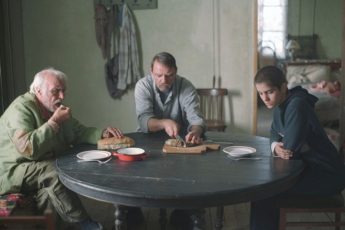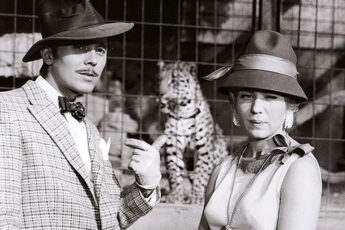The Dreams of a Realist
Corneliu Porumboiu’s Liviu’s Dream (Visul lui Liviu, 2004)
Vol. 55 (July 2015) by Moritz Pfeifer
In Corneliu Porumboiu’s first medium-length feature film Liviu’s Dream, a young man called Liviu (Dragoș Bucur) wakes up suffocating every morning but is unable to remember what dream makes him feel that way. Liviu lives with his brother and parents in a small flat in Bucharest and takes each day as it comes. He guerrilla-barbecues on the rooftops of Bucharest’s social housing blocks, makes some money in the vast networks of Romanian’s shadow economy, and leads an uncommitted relationship with his best friend’s girlfriend Mariana (Luiza Cocora). Everyone else in the film appears to be untroubled by their dreams. Liviu’s brother laughs in his sleep; Mariana dreams of a stable, marital life abroad; his peers are ambitious about chasing after big money. Only Liviu can’t fit in.
Poromboiu’s film analytically documents the wandering, often chaotic life of a generation having grown up during Romania’s transition period in a way that was, up to then, rarely seen in Romanian cinema. With the economy and morals still in crisis, many young adults in their early twenties were stuck between the anachronistic life-style and mentality of their parents and a future promising little room for dreaming.
In a final scene, we see a glimpse of the vision Liviu keeps having in his sleep. Liviu is in the dark, and a child with a creepy voice and a candle tells him that fish can’t drown – the kid may represent his illegally-aborted brother. (The film opens with black-and-white footage of a video documenting Ceausescu’s decision to criminalize abortion. Later we find out that Liviu was supposed to have another sibling, but his mother decided otherwise). Then he goes through a door and reaches the rooftop of a housing block, surrounded by a vast body of water. Nearby, another building is shipwrecking halfway under water.
For the last century or so, the interpretation of dreams has been a favored research ground for psychoanalysts. So it may be unsurprising that Liviu’s dream bares astonishing resemblance with a dream Swiss psychiatrist C. G. Jung described and analyzed in a his 1944 essay Psychology and Alchemy.1 Typically for Jung, whose utopian life project was to categorize dreams into archetypes, the dream is described in a simple scenario and followed by an explanation of its universal meaning. The scenario reads as follows:
By the sea shore. The sea breaks into the land, flooding everything. Then the dreamer is sitting on a lonely island.
Although Liviu stands on a building instead of an island, this is pretty much as accurate a description of his dream as one could find. Jung’s interpretation also strikingly matches Liviu’s troubled personality. Thus Jung observes that such dreams about the sea are “often irrational and incomprehensible to the person concerned […] which alienates and isolates him from his surroundings.” Interestingly enough, Jung even gives a plausible explanation to the appearance of the aborted child. “An illusory reality rises up in which weird ghostly shadows flit about in place of people. That is why primitive man has always believed that lonely and desolate places are haunted by “devils” and suchlike apparitions.”
Why do we have such dreams? Jung believed that the sea, because “unfathomed depths lie beneath its surface”, is a symbolic representation of the things society is unwilling to deal with. What is it that Liviu’s society refuses to confront? Well, it could be anything from the traumatic Communist past to the brutal capitalism that came after. But it really doesn’t matter, because whatever the collective unconscious is, it stays under water. No wonder that the person dreaming such a dream often freaks out. While no less unwilling to confront the danger hidden beneath the surface, the dreamer nevertheless gets reminded of that very fact.
The fact that the dream thus remains hidden to Liviu cannot be overstated. It disrupts the symbolic cinema of Romania’s previous generation of filmmakers. Although dreams rarely appeared as a subject in their films, aesthetically they relied on strongly anti-realist, symbolic, or dream-like elements. If Porumboiu’s film were such a symbolic film, the protagonist’s dream would materialize and the feared unconscious would resurface from the water as a decipherable symbol. But Porumboiu, unlike his predecessors, does not seem to believe in the power of such stylistic devices. He refuses to play the role of the authoritative dream interpreter who pretends to hold the key capable of unlocking a reality everybody else appears to be unable to decipher. This kind of symbolic arrogance was not uncommon in the films that dominated the 1990s. Pre-new wave directors loved to camouflage social malaise in baroque symbols, suggesting political superiority by self-stylizing the products of their dream fabric as subversive prophecy.
In Porumboiu’s film, the dream is simply the part of one person’s complicated, mysterious, and often absurd life and hardly provides the encyclopedic symbolism that would make it easy for him to look clearly into his intricate life. It is essentially a truly, to spit it out, realist way of dreaming. One of Porumboiu’s later characters may ask: why would the unconscious be called unconscious if we were conscious of it?




Leave a Comment